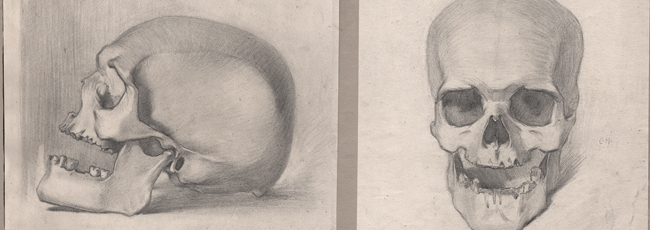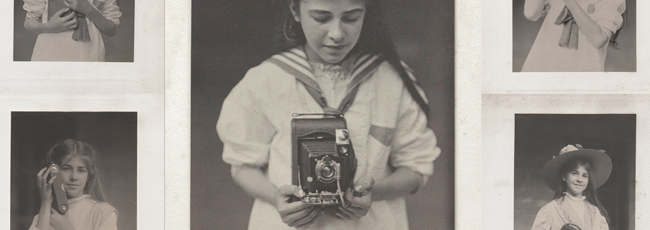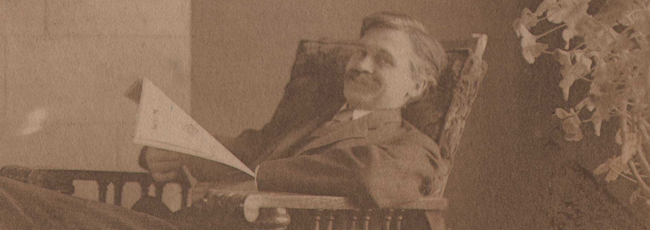Speaking of photography in general, of which this website is particularly enamored of, our recent visit to Rochester, New York and attendance in the three-day conference “PhotoHistory/PhotoFuture” sponsored and organized by RIT Press and The Wallace Center at the Rochester Institute of Technology gave new meaning to their claims for the medium: “there has never been more of it than there is today.” That might be stating the obvious, especially in 2018, but the new meaning part was my own takeaway and inspiration.
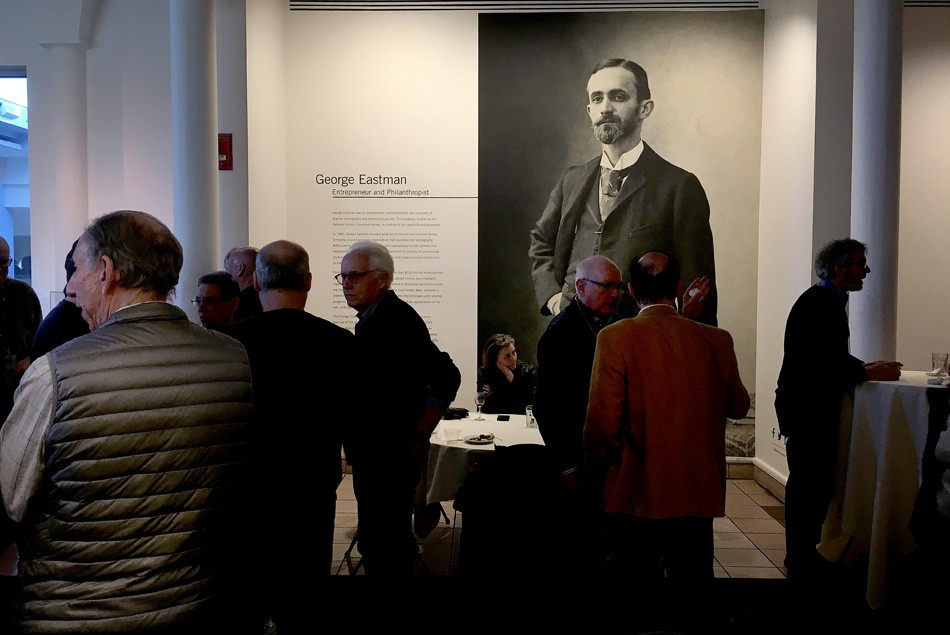
By George, Still Relevant: During a reception at the George Eastman Museum for conference attendees, a young George Eastman,(1854-1932) who founded the Eastman Kodak Company, looms larger than life in a photograph taken in 1890 by Nadar. Entrepreneur and Philanthropist are emphasized on the wall label, and with good reason. From the museum’s website:”The George Eastman Museum is located in Rochester, New York, on the estate of George Eastman, the pioneer of popular photography and motion picture film. Founded in 1947 as an independent nonprofit institution, it is the world’s oldest photography museum and one of the oldest film archives. The museum holds unparalleled collections—encompassing several million objects—in the fields of photography, cinema, and photographic and cinematographic technology, and photographically illustrated books. The institution is also a longtime leader in film preservation and photographic conservation.” David Spencer for PhotoSeed Archive
In present day Kodak city, the power of ideas relating to what made this place significant as an imaging industrial behemoth still exists, but has now gone in a new direction. With all due apologies, but the pun indeed appropriate, a snapshot of those ideas put forth by the conference attendees and speakers shows their passion for the medium’s minutiae both preserves and continues this essential democratic language. Those of memories past surely, but more and more the future in the form of ones and zeroes hurtling forward.
Although the “Big Yellow” of Rochester’s past is long gone, the ideas nourishing photography’s entire corpus continues apace, an alternate reality both present and future. For those curious enough, the RIT conference program along with a list of presenters can be found here, along with a few photos from the weekend courtesy of yours truly. David Spencer-
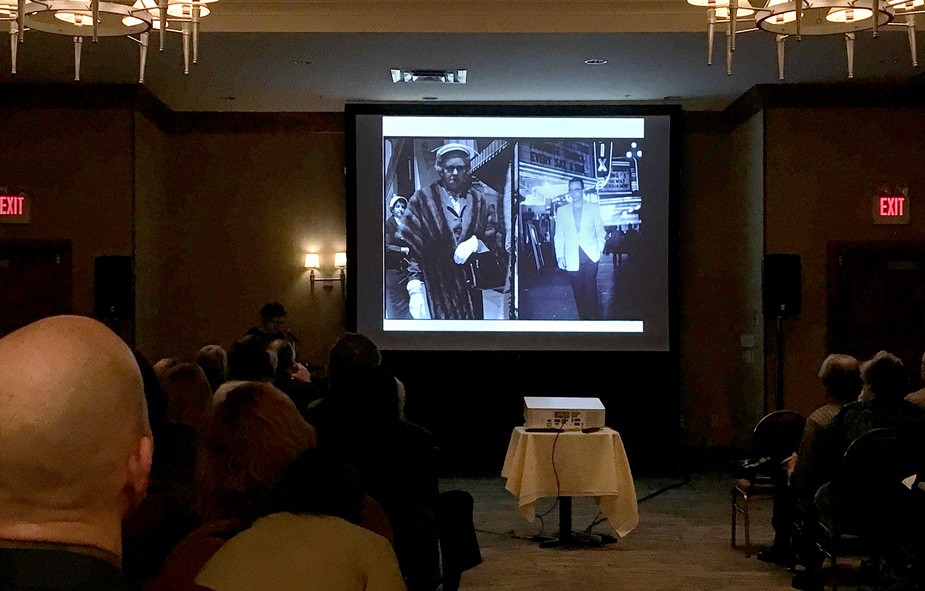
Documentary photography practiced as commerce on busy streets around the world, a genre roughly known as “Movie Snaps” because of the retrofitted movie cameras used in their making, was part of a fascinating presentation under the working title “Street Vendor Portraits Around the World: Czernowitz, Capetown, San Francisco, More!” given by independent scholar Mary Panzar of Rochester. Here, the hybrid look of Winogrand meeting Arbus becomes a document in a projected frame of a woman sporting fur and white gloves at left while a gentleman unaware at right emerges to flash and instant celebrity from a movie theatre on a nighttime street. David Spencer for PhotoSeed Archive

Triptych in the Dark: Left: During his presentation “Did Talbot Make Daguerreotypes?”, the eminence of English photography pioneer William Henry Fox Talbot (1800-1877) is shown here by an image most in attendance had seen, yet Grant Romer- formerly of the Eastman House but now Founding Director of the Academy of Archaic Imaging, challenged us with another view: a decidedly unflattering profile of the paper/negative pioneer he rightly remarked might have made for a different public perception for the emerging medium had it been the lone evidence of his existence. Middle: a quote of photographic philosophy by American writer Susan Sontag (1933-2004) struck this observer as particularly relevant in the present day- University of Illinois Springfield professors Kathy Petitte Novak and Brytton Bjorngaard used it as supporting evidence while speaking on “The Blurring Distinctions of Taking versus Making Photographs: Teaching Photography in a Digital Culture”. Right: the appropriated late Victorian era reality of the dark underbelly of a small Wisconsin town through the lens of Black River Falls photographer Charles Van Schaik repurposed by author Michael Lesy in his 1973 cult classic “Wisconsin Death Trip” was supporting material for Nicolette Bromberg of the University of Washington, who argued photographic archivists need to understand context in her paper “Loss of Vision: How Art Historians and Critics Misjudge Early 20th Century Photography and How Early Photographers Along with Art Museums and Archives Help to Obscure the Photographic Record”. David Spencer for PhotoSeed Archive

Photographic Preservation: With a mission statement stating they are the “world leader in the development and deployment of sustainable practices for the preservation of images and cultural heritage”, conference attendees toured the Image Permanence Institute, (www.imagepermanenceinstitute.org) which opened in 1985 as an academic research laboratory within the College of Imaging Arts and Sciences at RIT. For many visitors, IPI is known for their Graphics Atlas, (www.graphicsatlas.org) an online resource that helps identify photographic and other process print types. In front of a table with various displayed print types including a row of portraits toned with Polysulfide & Selenium Toner, Institute senior research scientist Douglas Nishimura at left chats with a visitor. David Spencer for PhotoSeed Archive
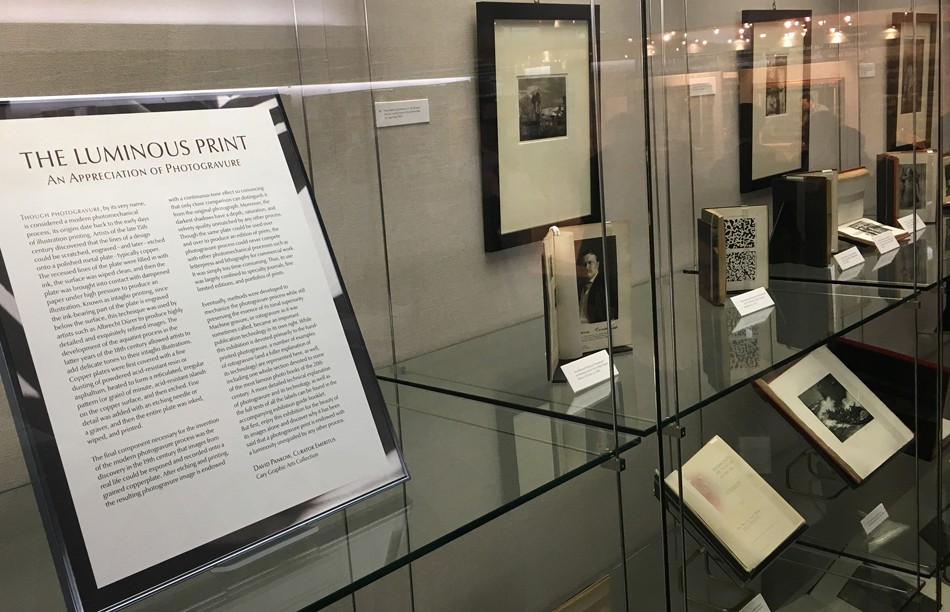
Conference participants attended the exhibition “The Luminous Print: An Appreciation of Photogravure” organized by David Pankow, Curator Emeritus for the Cary Graphic Arts Collection at RIT now running through June 15, 2018. With beginnings in intaglio printing by artists working in the late 15th Century, photogravure’s historical timeline which evolved by the 19th Century as a medium for “images from real life” is showcased by superb examples featuring plates from bound volumes, portfolios and individual works. The pleasure in real life can be seconded by this attendee, with the following observation from the catalogue true to form: “enjoy this exhibition for the beauty of its images alone and discover why it has been said that a photogravure print is endowed with a luminosity unequalled by any other process.”David Spencer for PhotoSeed Archive
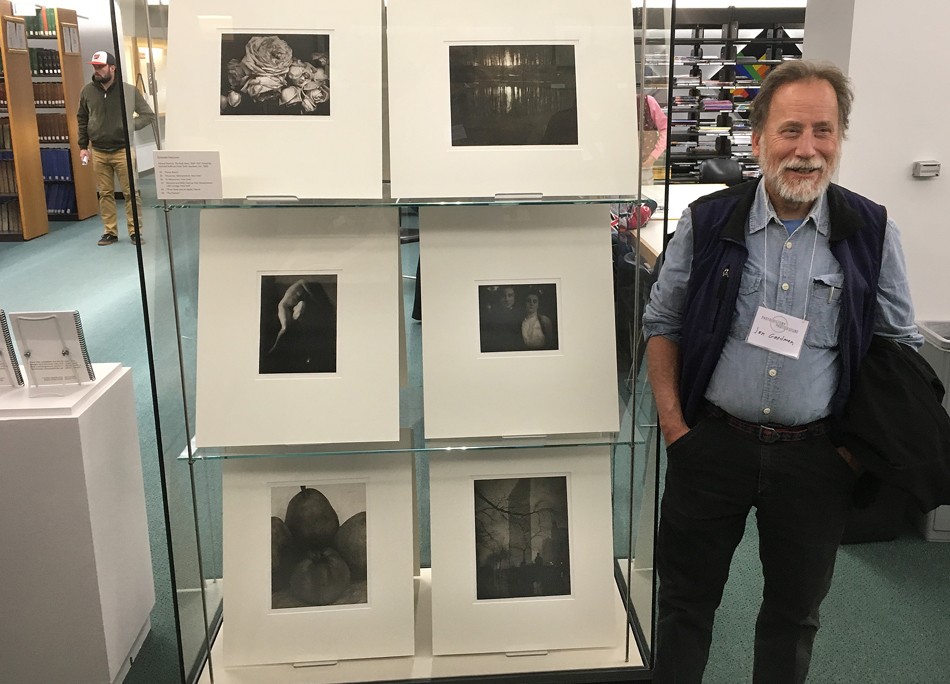
Royal Visit: As an added bonus, conference attendees viewing “The Luminous Print” could rub shoulders with Massachusetts resident Jon Goodman, a master craftsman who has worked full time since 1976 as a photogravure printer specializing in the Talbot Klic photogravure technique . Beginning in 1980 through the Photogravure Workshop, a division of the Aperture Publishing Foundation and their namesake Aperture magazine and the Paul Strand Foundation, Jon has produced sumptuous, superb, and collectable portfolios of the early work of Paul Strand, Edward Steichen, and British photography. His mission continues today in his Florence, MA atelier along with a new interest: carbon printing. Displayed are six of Jon’s gravure plates featuring the pictorial work of Edward Steichen from the 1981 Aperture portfolio: “Edward Steichen; The Early Years, 1900-1927”. Top to bottom left to right: “Heavy Roses”, “Moonrise, Mamaroneck, New York”, “In Memoriam, New York”, “Steichen and Wife Clara on their Honeymoon, Lake George, New York”, “Three Pears and an Apple, France”, “The Flatiron”. Visit jgoodgravure.com and gravureportfolios.com for more information. David Spencer for PhotoSeed Archive

History of Printing: A series of oil paintings by three artists originally commissioned in 1966 by the Kimberly-Clark Corporation commemorating “Graphic Communications through the Ages” hangs within the offices of the RIT Press ( www.rit.edu/press/ ) and the adjoining Cary Graphic Arts Collection at The Wallace Center. This painting shows a detail of the work “George P. Gordon and the Platen Press” done by American illustrator Robert A. Thom, (1915-1979) with a detail at right by Thom: “Ira Rubel and the Offset Press”. David Spencer for PhotoSeed Archive
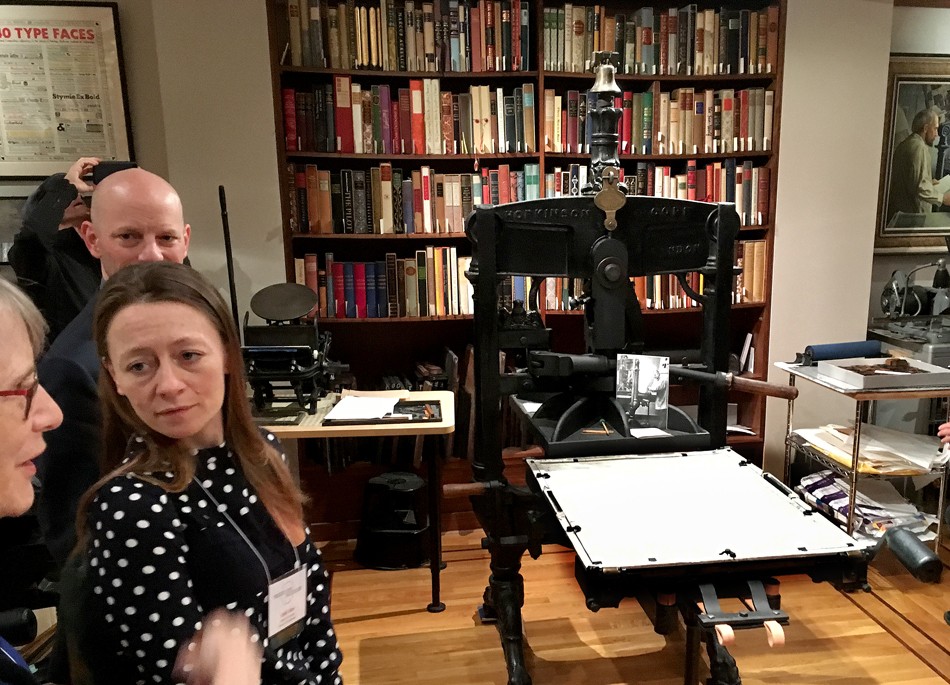
Making an Impression: Taking center stage for visitors is the famed Kelmscott/Goudy iron hand-press featured among other working presses in the Arthur M. Lowenthal Memorial Pressroom within the Cary Graphics Arts Collection at RIT. Visitors learned it was first owned by the English printer William Morris and then Frederic Goudy, two giants of the letterpress printing art. The press was built in London in 1891 by Hopkinson & Cope- an Improved Albion model (No. 6551). Now featuring around 40,000 fine and rare volumes on graphic communication history and practices, The Cary Collection is considered one of the premier libraries on the subject in the United States. ( library.rit.edu/cary ) David Spencer for PhotoSeed Archive
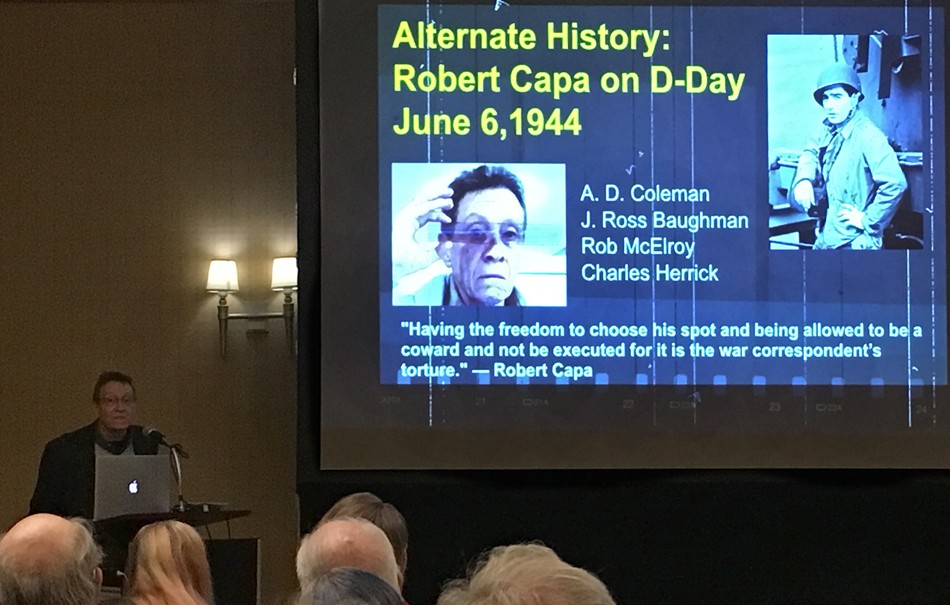
Alternate History: The coverage by war photographer Robert Capa (1913-1954) for Life Magazine of American troops landing on Omaha Beach on D-Day during World War II was deconstructed after seven decades of public myth to facts by Staten Island, NY independent critic and historian A. D. Coleman. The first photo critic for the New York Times in 1967 and prolific author of books on photography as well as thousands of articles on the medium, Coleman presented his research during the conference titled “Deconstructing Robert Capa’s D-Day: The Unmaking of a Myth” that recently took place over three years helped by the efforts of war photographer J. Ross Baughman, Rob McElroy and Charles Herrick. As a former photojournalist myself for over three decades, I found his presentation convincing and enlightening: I still remember drying strips of film as a young photographer in large upright darkroom cabinets-the focus of some of the research when it was claimed a Life lab tech had melted Capa’s film on deadline- the worst I remember was curled film! Please visit capaddayproject.com to learn more. Malcolm Gladwell, (revisionisthistory.com) are you interested? David Spencer for PhotoSeed Archive
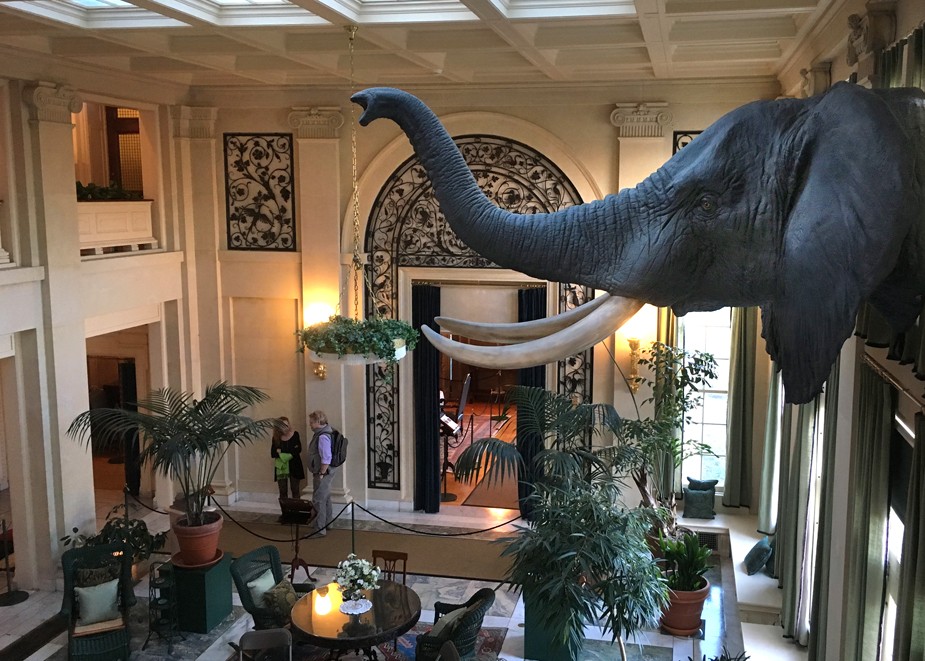
Digital Elephant in Room: Visitors to George Eastman’s stately 50-room Colonial revival mansion adjoining the Eastman Museum will always remember the conservatory, where a fiberglass replica mount of an African bull elephant hangs- a conquest by the company founder during a 1928 Sudanese safari. Conveniently- and speaking of elephants in the room, I earlier had thoroughly enjoyed listening and pondering conference presenter Stephen Fletcher’s talk: “The Photographic Archivist is Dead, Long Live the Photographic Archivist!”, his call to action for the task of photo archivists in the 21st Century: what do we do and how do we preserve a portion for posterity and history the digital evidence of billions and billions of photographs taken-seemingly, every day? A photographic archivist in the North Carolina collection at the University of North Carolina at Chapel Hill, Fletcher’s call to arms would surely have inspired Eastman himself, a hands-on guy who is reported to have overseen every aspect of the construction of his mansion and made sure it contained all the cutting-edge technology of its’ day: from the Eastman Museum website: “Beneath this exterior were modern conveniences such as an electrical generator, an internal telephone system with 21 stations, a built-in vacuum cleaning system, a central clock network, an elevator, and a great pipe organ, which made the home itself an instrument, a center of the city’s rich musical life from 1905 until Eastman’s death in 1932. Eastman was involved in every aspect of the construction, paying close attention to detail and requiring the use of high-quality materials.” David Spencer for PhotoSeed Archive
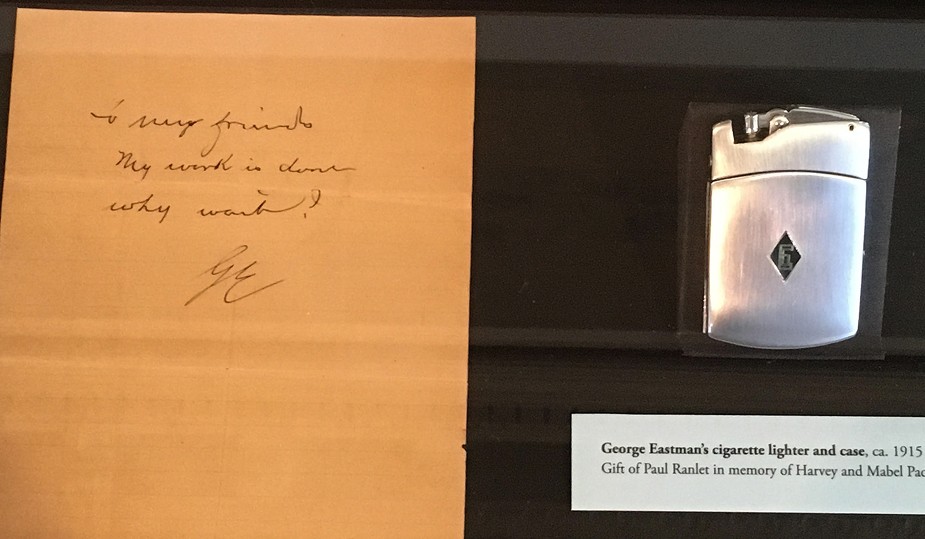
Smoking also Works: Perhaps the most startling object on display in the mansion-at least to those who do not know the intimate details of George Eastman’s life- is a facsimile of his 1932 suicide note: “To my friends – My work is done – why wait? GE.” Suppressed initially by the Eastman Kodak Company for decades, this news is sobering but important. Eastman had been crippled by a degenerative spinal disease and unable to walk, he shot himself through the heart in his upstairs bedroom. A music lover even after the end, a 1990 New York Times story on the renovation of the mansion noted he “requested a rousing ”Marche Romaine” by Charles Gounod be played at his funeral”. David Spencer for PhotoSeed Archive
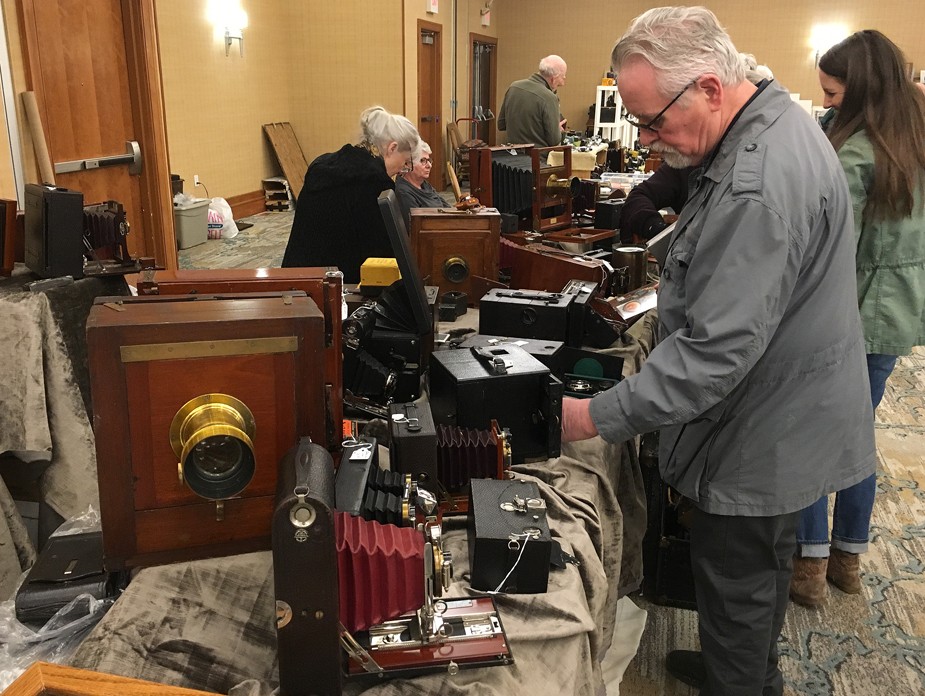
Fancy Box with Hole in It: Collectors and the curious had the opportunity to peruse the physical evidence of the history of photography during the concluding event of the conference, an antiquarian photography show and sale featuring 80 tables of wares including these vintage wooden box and Kodak cameras. Earlier, the RIT Press and Syracuse University Press showed off their latest offerings, including some wonderful photography volumes during the event. David Spencer for PhotoSeed Archive

Learned from Jon Goodman: During the antiquarian photography show and sale, Ontario-based visual artist David Morrish, co-author along with Marlene MacCallum of the 2003 volume “Copper Plate Photogravure: Demystifying the Process”, shows off a page spread of original photogravures from his 2004 Deadcat Press imprint “Gaze” he was selling along with other work during the antiquarian photography show and sale. Earlier in the conference, Morrish and visual artist MacCallum, former professor in the Visual Arts Program at Memorial University of Newfoundland, presented on “Photogravure: Then and Now” highlighting the gravure process while showing how the medium’s ongoing relevance to contemporary art practice has influenced their own work in the production of print suites and artists’ books. Learn more at marlenemaccallum.com and davidmorrish.com. David Spencer for PhotoSeed Archive
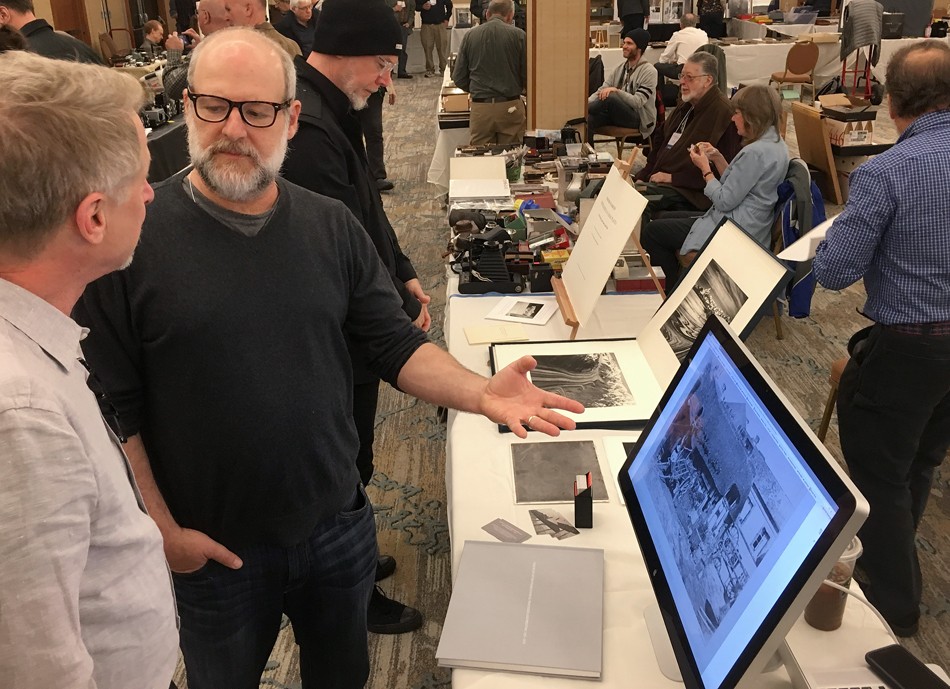
Future with a Past: St. Louis resident and commercial photographer Mark Katzman, the key force in proselytizing for the medium and beauty of hand-pulled photogravure worldwide through his website Photogravure.com, speaks with conference speaker Jeff Rosen during the antiquarian photography show and sale. Curious to learn what a real photogravure is, unlike the many who simply use the term-wrongly-to sell you something not what they claim? Head over to his newly redesigned site, where the mission statement is: “Peeling back a layer of the history of photography, this site examines the role that photogravure has played in shaping our shared visual experience. Through exploring thousands of examples, we learn about the relentless and ambitious 19th century pursuit to reproduce photographs in ink and discover the exquisite, sublime process that resulted. It is our hope that this site firmly establishes photogravure as not only one of the most under-recognized photographic processes, but also an important and beautiful art.” David Spencer for PhotoSeed Archive

Keeper of Memories: Located at 900 East Ave. in Rochester, New York, the George Eastman Museum, along with a section of his original mansion and gardens on 8.5 acres constructed beginning in 1902, is a grand American repository for the study of photography past, present and future. Besides a growing archive of over 400,000 photographic objects spanning the history of the medium, the museum also features 16,000 + examples of photographic and cinematographic technology- the world’s largest. For those interested in the printed legacy, the accessible Richard and Ronay Menschel Library is also onsite, with a special collections and archive division housing “manuscripts, papers, and ephemera, including those of Alvin Langdon Coburn, Lewis W. Hine, Southworth and Hawes, and Edward Steichen, among other photographers, collectors, and inventors.” Curious? eastman.org. David Spencer for PhotoSeed Archive
